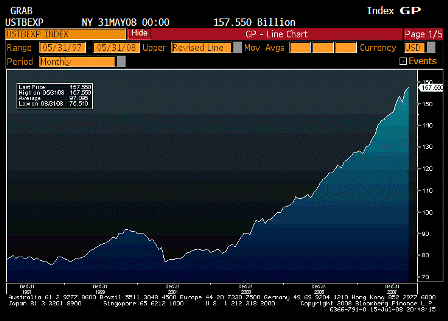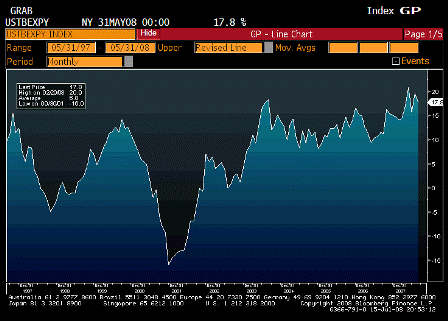Here’s my take on the events of the last year:
Paulson/Bush/Bernanke pressed a ‘weak dollar’ policy to use exports to sustain GDP, rather than a fiscal package to support domestic demand.
This kept the US muddling through but took demand from the rest of world.
The rest of world had become ‘leveraged’ to their exports to the US.
As US imports fell and US exports accelerated, the rest of world economies slowed and support was removed for their credit structures.
No government moved to support domestic demand until the modest US fiscal package of a few months ago. It was too little too late.
None of the credit based economies have the institutional structure to sustain growth and employment with soft asset/collateral prices.
No private sector loans are ‘safe’ when collateral values and income are falling.
The lesson of Japan is that with a general deflation of collateral values it took a federal deficit of at least 8% of GDP just to stay out of recession.
Not sure what it will take here.
The payroll tax holiday would be a good start and probably sufficient to reverse the shortfall of demand.
The US, UK, Japan, etc. will survive a slowdown due to their ‘automatic stabilizers’ that will rapidly increase deficits until they are sufficiently large to turn things around.
The eurozone doesn’t have the institutional structure that will allow this process to work as it does in the other nations with non-convertible currencies.
The eurozone can only hope the rest of world recovers quickly and supports eurozone exports.
Without a US fiscal package US domestic demand will remain weak until the deficit gets large enough via falling tax revenue and rising transfer payments.
Without foreign CB buying of USD, US imports will not increase enough to support rest of world demand.
All this means a decisive US fiscal response, such as the payroll tax holiday, will support:
- Both US and rest of world aggregate demand.
- Support the financial sectors from the bottom up.
- Increase US real terms of trade.
(Not to forget the need for an energy package to keep higher crude prices from hurting our real terms of trade and reducing our standard of living.)
[top]



